QCF: The TurboGrafx-16 Mini
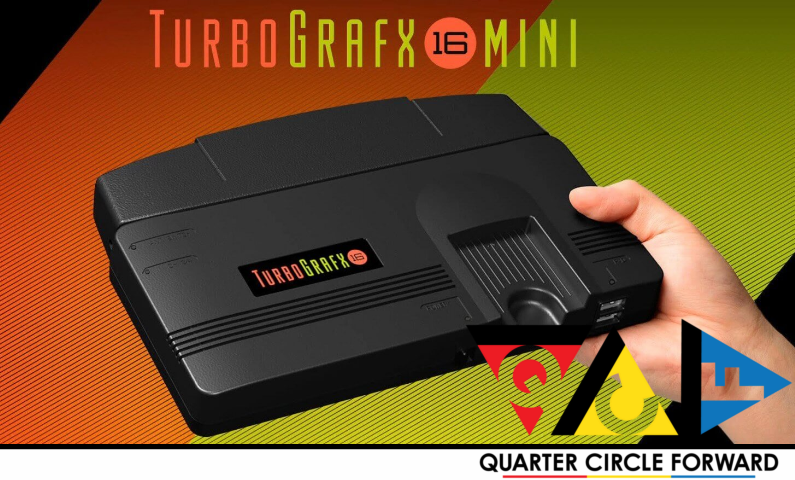
 or all the times you heard the arguments on the school playground of who did it better, there was always that weird kid who managed to sneak an underdog into the conversation. Pepsi versus Coke-Cola had RC Cola, DC Comics versus Marvel Comics had Image, and The Super NES versus the Sega Genesis had the unassuming TurboGrafx-16; an upstart machine with a unique design and library that was unlike anything else available on the market in the early nineties.
or all the times you heard the arguments on the school playground of who did it better, there was always that weird kid who managed to sneak an underdog into the conversation. Pepsi versus Coke-Cola had RC Cola, DC Comics versus Marvel Comics had Image, and The Super NES versus the Sega Genesis had the unassuming TurboGrafx-16; an upstart machine with a unique design and library that was unlike anything else available on the market in the early nineties.
Nowadays the console has earned a cult following that’s elevated the resale value of the hardware and games into the upper hundreds, but in doing so, the platform had deterred any interest from the casual retro gaming spectator market that has ballooned over the past decade. Nevertheless, thanks to the growing popularity of miniaturized versions past gaming platforms running on modern emulation technology, the trend has motivated Konami to join the tiny ranks with the release of the TurboGrafx-16 Mini.
Developed in part by the luminary studio of Japanese retro gaming, M2, The Pachinko giant has commissioned the production of three different models for the line that are respectively based on the console’s regional runs; the PC Engine Mini, PC Engine CORE Mini, and the TurboGrafx-16 Mini. This review will focus solely on the TurboGrafx-16 Mini, as to center the assessment on the experience it promises within the context of the 16-bit generation from an American perspective—specifically in terms how made the system a brand in the west, along with the choice of imports included to cater to the sensibilities of the western market, and more.
With that being said, the TurboGrafx-16 Mini hits the road impressively hard to catch up with likes of the SNES Classic and Sega Genesis Mini, but fumbles the landing from a slew of shortcomings that ultimately keep it from reaching beyond the same crowd that’s been cheering it on the machine from the start.
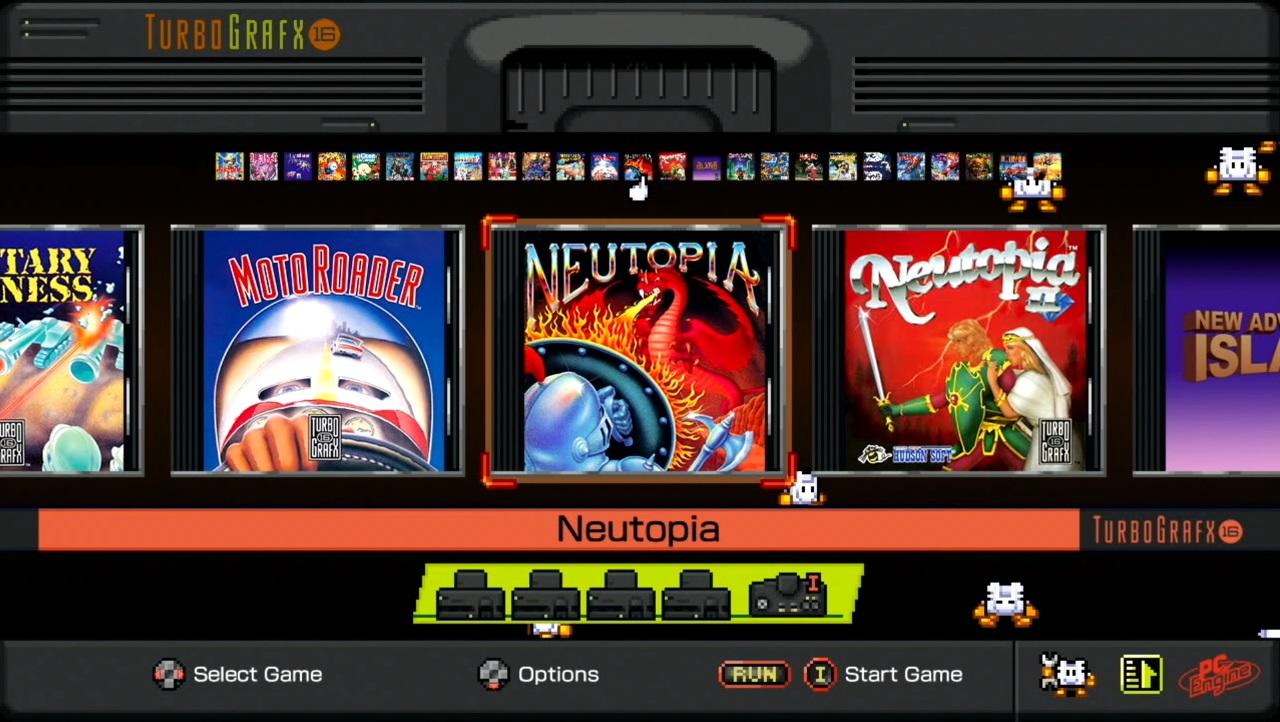
One of the most striking things about the TurboGrafx-16 Mini is the amount of charm that was poured into the presentation of its package. Aesthetically, the physical cosmetics of the hardware are articulated with frightening attention to detail. Even on a smaller scale, the framework feature’s all of the exaggerated embellishments of the original, from the curvy ridge panels that adorn the familiar matte plastic of the system, to the exaggerated diameter of the interface that housed the modestly sized internals, so much so that the Mini measures out at 2/3 of the original TurboGrafx-16 in total size. The console even retains the detachable back-cover that concealed the connection ports, recreating the placement for the USB Power Cable and HDMI Cable to poke out of, and still delivering that impractical, yet, unique appearance of the original. The most significant change is the number of controller ports the system comes stock with, as the Mini allows for two from the start in contrast to the predecessor’s one, making it easier to mull over the decision to purchase the maligned “Turbo Tap” that’s also making its return the accessory lineup for the Mini.
The Controller is even more impressive in its accuracy with dimensions that are nearly identical to a bonafide TG-16 controller, featuring the same button tactility and responsiveness—and another key element that was strangely omitted from the other Mini variants, the trademark Turbo switches that measured the triggering speed of the action buttons. The weight and feel of the controller is the only discernible difference for those who’re familiar with the classic iteration of the platform, as the Mini’s controller is slightly lighter by comparison— not to mention the added length of the cord in this revision that allows you to comfortably play games without being confined to eight inches away from the television screen. Overall, the differences don’t do anything to hamper what is otherwise a fantastic remake of the source material.
The spectacle of the TurboGrafx-16 Mini doesn’t stop at the physical cosmetics of the system though as the system UI is truly a whimsical sight to behold. At first glance, the Mini default’s to the TG-16 lineup of software in a gallery-style arrangement similar to that of the NES/SNES Classic, with a myriad of visual flourishes and effects spread throughout the screen. The colors of the UI emulate the themes and pastiche of their respective hardware, along with a dozen little PC Engine mascots that resemble the system’s caricature from game Star Parodier. The most delightful of these flourishes is the display of the Turbo Chip/HuCard slot at the top of the screen. Each game that’s booted up for play will initiate an animation of a virtual card for the title being visually inserted into the slot for play, just like the real deal—even the CD software will display the respective System card needed for that specific game to play in a similar show of fan service, along with a pixelated recreation of the disc spinning up in the CD Bay—it’s such a small touch that adds an immensely satisfying element to the TG-16 Mini’s experience. Even save stating games will cut to three files that illustrate the Tennokoe2 peripheral that originally offered storage for compatible software as one of its key features, it’s a level of tribute that isn’t found in any of the other legacy Minis on the market.
On to the meat and potatoes of the TG-16 Mini’s utility, the Options menu offers various settings to tweak the specific output of your display in terms of ratio, scaling, and wallpaper—the resolution is staunchly locked at 720p though.
The scale and ratio options cover a wide variety of options. The first being is once again, similar to the Nintendo miniatures as there is the standard 4:3 ratio, and the Full 4:3 display. The standard 4:3 can vary in coverage due to the unique pixel resolution of the TurboGrafx-16/PC Engine, as the option might cut off the vertical dimensions of the image on screen depending on what your display is. For comparison, this output option was individually tested on both a Samsung 27” TX-S2783 HD CRT TV where there was no cutoff, and a VIZIO 43” Class 4K HDR Smart TV where there was. The full 4:3 however will ensure prevent any vertical cutoff for the display at the risk of disproportioned pixel sizes that may especially stick out in some software more so than others, especially during moments where games will vertically scroll.
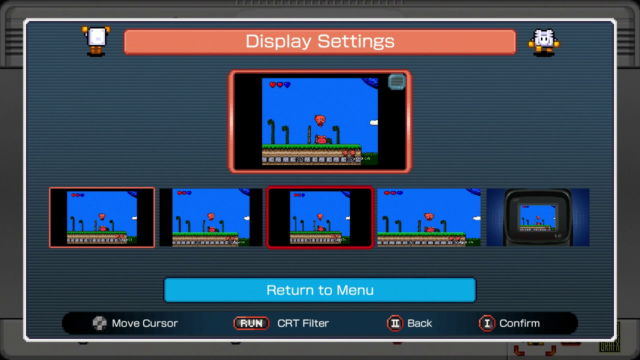
The next option is a “pixel-perfect” ratio which significantly reduces the horizontal real-estate but does help reduce the typical artifacting defects that plague modernized retro game displays like shimmering, and screen tearing, though games that are infamous for these issues like Ninja Spirit, and R-Type still retain some elements of shimmering and tearing despite the application of this output option. The fourth option is a stretched out 16:9 display of the image, scaled to fit every inch of the display—which is fine for those who want to have the option available, though it should be said that anyone who plays retro video games in 16:9 is a cop. The final option is more of a quirky Easter egg than anything else—an emulated screen of the Turbo Express/PC Engine GT screen mode, complete with a high-resolution overlay of the portable system itself, and a screen that’s willingly emulating the 400x270 Pixel resolution with exaggerated dithering filter that only serves the argument that portable gaming tech was such an unintelligible mess in the nineties.
Another visual flair the option to add an artificial CRT filter, which is available for all of the options except for the Turbo Express/PC Engine GT option, is novel but visually unappealing, especially to the superior CRT filter that M2 developed for the Sega Genesis Mini. To elaborate, the CRT filter that the Sega Genesis mini offered gave the screens a BVM quality with its chunky scanlines, the TG-16 Mini, however, tries to go for a composite video quality that ends up dimming a lot of the color and brightness of the graphics on-screen, and only works to detract from the overall visual quality.
While the magic of nostalgia is strong with the TurboGrafx-16 Mini, its only as strong as the frames that are used to prop up the rose-tinted lenses it pores through; the unfortunate truth is that the technical performance under the TG-16 Mini’s hood is disappointing at best, and immensely frustrating at worst.
Bouncing back to the visual fidelity of the system, the iconic color and confectionary graphics of Hudson’s 16-bit wonder are flaunted in gorgeous detail for a high definition screen, but it’s unfortunately at the expense of unforgivable lag. All 57 packed in titles suffer from a degree of lag, both in terms of sound, and controller response—everything from sound cues, to contextual jingles will all play anywhere from 6-7 frames later if measured at the speed of 60 frames per second. To be fair, this issue isn’t exclusive to the TG-16 Mini by any means as the other pieces of 16-bit Tiny Tech also suffer from a noticeable degree of sound delay (especially the Genesis Mini) but on the flaw just drags down the Turbo more so. A lot of the action-heavy software offered in the Turbo library significantly relies on the frenetic rhythm of its sound design, so little things like the gunfire in Spriggan, or the grunts in Lords of Thunder playing even a millisecond too late can be really jarring, emphatically more for faithful veterans of the hardware.
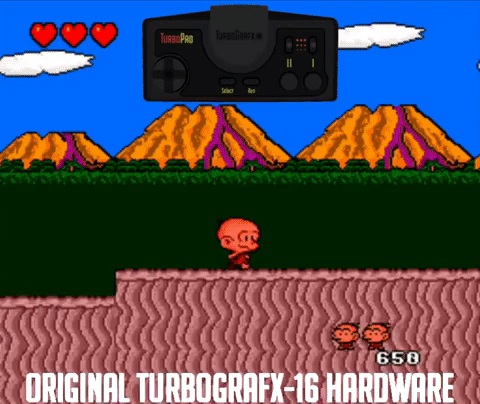
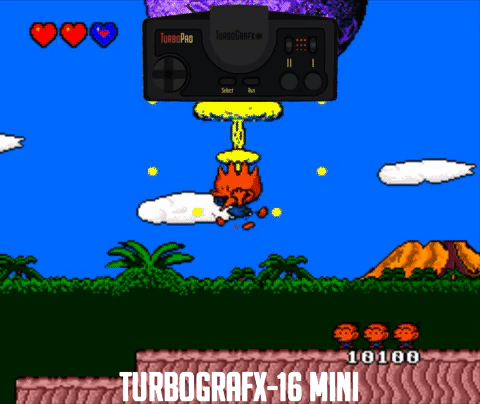
As you can see between the two captures, the TG-16 Mini forces players to plan three steps ahead just to excecute the simplest of actions.
However, the most egregious element of the console’s laggy performance is the response time, which again, can be a crucial deal-breaker for a majority of the twitchy titles in the game lineup. Using Bonk’s Adventure (or PC Genjin in this instance, which, geez, more on that in a moment) as an example, the game’s challenge is fairly easy-moderate difficulty platformer with a lot of reactionary design involved in the enemies and stage design of the game, can devolve into a frustrating exercise of your patience with its lag time. Applying the same measurement of 60 frames per second, response time for button input on the game can be anywhere from 3, to a staggering 5 frames slower in execution than that of the original system plugged to an analog display—and this issue is only more exacerbated in one of the many packed-in shoot’em up games for the system.
The fact that the state of the TG-16 Mini’s emulation was shipped like this under the watch and care of M2 of all studios is even more disheartening, especially when their work with the Sega Genesis Mini was so much more indicative of their technical pedigree with retro game emulation. M2 isn’t entirely to blame for the TG-16 Mini’s squandered potential though—Konami’s management over the software included for the micro redux leaves a lot to be desired as well.
A lot of the TurboGrafx experience hinged on the stellar import scene it offered, mainly due to the paltry figure of western releases that actually made it to North America, we’re talking 139 titles across three different formats, in five years on the market. So naturally, it came as no surprise when Konami confirmed that there were going to be 25 TurboGrafx 16 entries, joined by 32 additional PC Engine titles, coming to a whopping 57 total titles to choose from. While some of them are staples of the Turbo/PC Engine legacy, there are a surprising number of poor choices that could have better deliberated on titles that are far more deserving. Let’s address the big elephant in the room—four of the TurboGrafx 16 games included have their 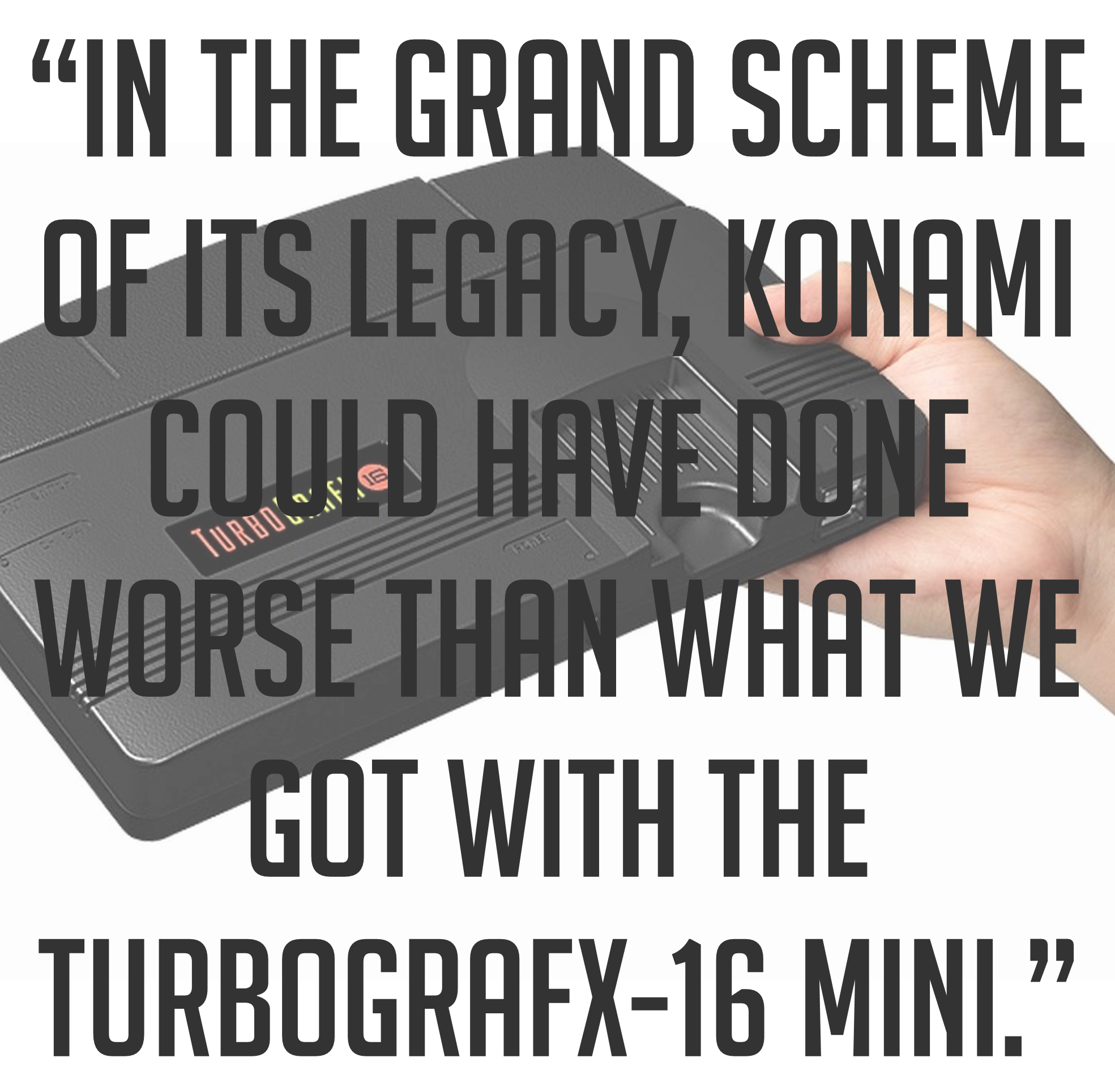 PC Engine counterparts alongside them as well; Neutopia, Dungeon Explorer, Military Madness, and Y's Books I & II—let me tell y’all this fast and simple, there was absolutely no need for that.
PC Engine counterparts alongside them as well; Neutopia, Dungeon Explorer, Military Madness, and Y's Books I & II—let me tell y’all this fast and simple, there was absolutely no need for that.
Giving the benefit of the doubt that these titles are all text-heavy games that’re unplayable beyond a language barrier, the unique regional assets between these four titles are extraordinarily minuscule. There is no excusable reason why Konami and M2 couldn’t have had implemented the option of a regional switch for these four games so that the extra four spots taken could have gone to another title, especially when you factor the glaring omissions of cult-classics like The Legendary Axe, Magical Chase, or Fantastic Nights Cotton. Adding further insult to injury, there’s another chunk of software that is also unplayable for the non-Japanese fluent player as additional text-heavy titles like SNATCHER, Super Momotarō Densetsu II, and Jasseiken Necromancer are thrown in without any sort of English translation, filling up three more spots that would be better reserved for the likes of Gate of Thunder, The Dynastic Hero, and Riot Zone.
That isn’t to say that the overall library is total shit though, as the remaining selection includes gangbusters like the SuperGrafx port of Daimakaimura, the must-have Akumajō Dracula X: Chi no Rondo, and the mortgage-refinancing resale monster Ginga Fukei Densetsu Sapphire on the list—it just could have been so much more. When you browse the list and come across picks like PC Genjin on the PC Engine side, to Bonk’s Revenge on the Turbo half, it’s clear that Konami attempted a one-size-fits-all-approach that just didn’t flow the way it could have.
In the grand scheme of its legacy, Konami could have done worse than what we got with the TurboGrafx-16 Mini. It’s just a shame that this modern revision of the classic hardware left so much on the table, more notably during a moment in time where there are so were there eyes both old and new so firmly interested in it-a feat Hudson Soft and NEC struggled to accomplish in the System’s prime. I still recommend grabbing it, as the hardware arguably has more going for it than against it, just get ready to temper your expectations a bit when you’re struggling to get past the third boss in Soldier Blade because the lag is way harsher than it should be.





 GeorgieBoysAXE
GeorgieBoysAXE




